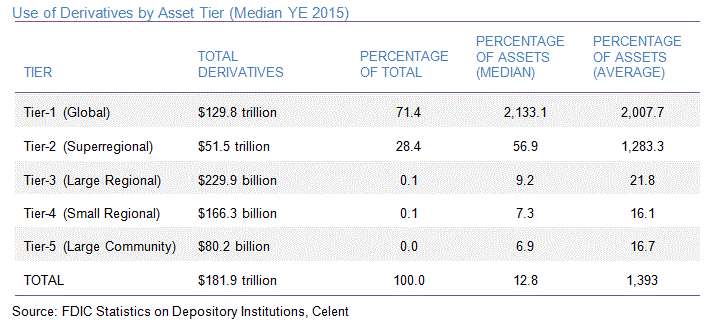A Banker’s Guide to Derivatives: The Role of Derivatives in Risk Management
Abstract
Managing financial risk is imperative to maintain the health and integrity of the banking industry, and for banks of any size the management of interest rate-based risk (IRR) is an important component of risk management strategy. This report highlights the financial implications of smaller banks' reliance on OTC swaps to manage IRR, examines the likely impact of new margin requirements, and suggests best practices for IRR management.
In the new report A Banker’s Guide to Derivatives: The Role of Derivatives in Risk Management, Celent examines the role that derivatives play in the management of IRR. The report analyzes the extensive use of derivatives at Tier 1 and Tier 2 banks in contrast with the lower use of derivatives at smaller banks (Table 2). The report goes on to review the correlation between bank financial performance and the use of derivatives, study the role of derivatives in a bank’s overall financial risk management program, and highlight several best practices.

“Bank regulators have been paying close attention to interest rate risk since 2010, and are particularly interested in banks that have been chasing yield by funding long-term fixed rate loans with short-term floating rate deposits,” says James O’Neill, senior analyst with Celent’s Banking practice and author of the report. “The introduction of margin requirements on over-the-counter rate swaps beginning next month represents a call to action for banks to review their IRR management practices and particularly the role that rate forwards and futures should play in their overall financial risk management program.”
Tier 3 and Tier 4 banks can share in the benefits of derivatives usage enjoyed by the larger banks by putting in place three key initiatives: a formal Board education program, the introduction of a modern TMS platform, and the diversification away from simple OTC rate swaps and toward a more balanced portfolio of rate-based derivatives. Banks that move forward on these three fronts will not only enjoy higher levels of regulatory compliance, but will be in much better shape to weather the economic waves that will eventually come when the global economy achieves normalcy and the yield curve makes its inevitable return to historic norms.

